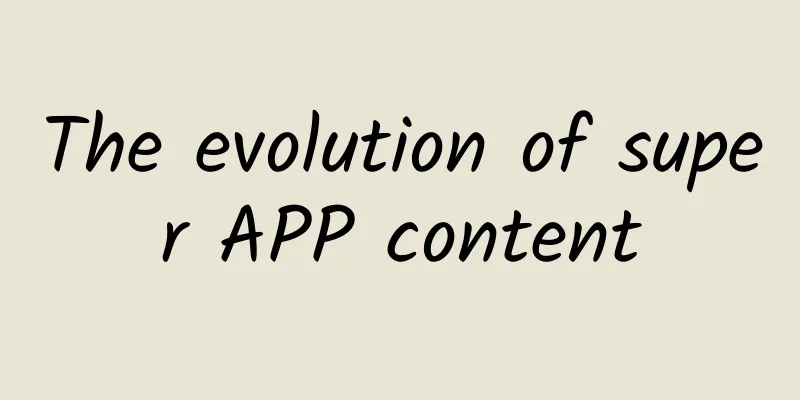The evolution of super APP content

|
Reviewing the three major super apps under BAT, including WeChat, Alipay, and Baidu App, their development paths are actually the development paths of China's Internet. They represent the three levels of China's Internet social, e-commerce, and search. The growth trajectory behind the super apps, from tools to content, from platforms to ecological chains, each has the same growth path, but also has its own characteristics. The common point is that they attach great importance to content, but in terms of content construction, they have different focuses and different approaches. Content layout of super APP WeChat: As we all know, when WeChat was first created, it was a pure mobile social tool. It was used for making friends and chatting, nothing more. Since its official launch in August 2012, WeChat Official Account has started to focus on content. But to the surprise of many people, WeChat does not want to be a content platform. When talking about making mini programs, Zhang Xiaolong said: "The original intention of making a public platform was to make a service platform, not to make a content or media platform, but in fact it became like this, so we made a service account, but the performance of the service account was not good. So, we started to consider making an application account." In other words, the core of WeChat is not content, but service. However, WeChat official accounts have triggered the explosion of self-media content, which has become a fact. According to the latest data this year, the combined monthly active accounts of WeChat and WeChat reached 1.058 billion, an increase of 9.9% over the same period in 2017. WeChat has achieved absolute coverage of domestic mobile Internet users. The WeChat ecosystem has formed an intricate and mutually reinforcing traffic and monetization system, including WeChat, mini-programs, official accounts, WeChat payment, and e-commerce. WeChat has generated a multi-level, ecological, comprehensive model in Moments and official account advertising, content payment, social e-commerce, mini-programs, mini-games, and tool applications. Currently, there are more than 20 million WeChat official accounts, with more than 3.5 million active accounts. At present, WeChat official accounts have transformed from simple content dissemination to a commercial platform, forming a closed-loop business model including advertising promotion, e-commerce, content payment, and paid rewards, and a large number of companies are brought together and connected through official accounts. The popular mini-programs have further accelerated content distribution. Baidu App: Unlike WeChat's "accidental creation", Baidu's content ecology is an "active layout". Baidu started out with search technology. From the original simple "search" to the current "search + push" dual-engine model of Baidu App search + information flow, Baidu's "content ecology" was born - in addition to "searching" the original corporate, media, and personal websites, pages, and information, it "pushed" its own content and service platforms, such as Baijiahao, Haokan Video, and smart mini-programs. This combines the dual functions of search and intelligent information recommendation, turning Baidu APP into a search + information platform. At present, Baidu's AI, voice, image and other technologies are serving both on the mobile side. The latest data shows that Baidu App has an average of 160 million daily active users, 6 billion daily search responses, and 15 billion daily recommendations in information flow. Unlike WeChat's decentralization, Baidu APP has become the largest platform for centralized content distribution in China. As an "active layout", Baidu APP launched a new initiative of "content diversification and service integration" at the 2018 World Conference. In terms of content form, it provides pictures, pictures, panoramas, short videos, small videos and other forms, and subsequent games and other forms will also appear; in terms of service, the launch of "smart mini-programs" is considered by the industry to be a product directly benchmarked against WeChat mini-programs. Currently, WeChat mini-programs are based on social functions, while smart mini-programs win users in "finding". For example, Kuaishou, iQiyi, 58.com and other companies that have become the first batch of smart mini-program open source alliance partners are more in line with the "search" gene. Data shows that Baidu's smart mini-programs, which were announced to be launched in July, have 120 million monthly active users and have penetrated 23 major industries and 262 sub-sectors. The latest Baidu App is positioned as a "comprehensive content consumption and service platform", with Baijiahao and smart mini-programs becoming the core of its content ecosystem. It can be said that the content ecology of WeChat and Baidu APP is a representative form of the two major paths of "decentralization" and "centralization". Alipay: The second generation of the rich At the beginning, Alipay was just a payment tool. While developing independently, it was integrated into the financial platform of Ant Financial and Alibaba. In addition to the familiar financial functions such as payment, it has also been improving its content layout. After the revision, Alipay launched functions with content attributes such as Life Account and Life Circle, which distribute content and services, and opened up the function of Weibo content distribution. Alibaba's Q2 quarterly report for fiscal year 2019 revealed that as of September 30, Alipay had more than 700 million annual active users in China. The number of users of the Alipay mini program launched in 2017 has exceeded 300 million. However, Alibaba Group has always attached great importance to content. It has acquired and invested in content platforms such as Youku Tudou and Weibo, and has also added videos and other content to platforms such as Taobao and Tmall. Why do super apps need to create content? Compared with commercial systems such as payment, although the content system has a long construction cycle and commercial monetization takes time, it plays a huge role in promoting super apps and ecological construction in terms of user stickiness and activity. WeChat: Although Zhang Xiaolong said that WeChat official accounts do not want content, but services. However, since content plays an irreplaceable role in user activity and stickiness, it can provide a foundation and carrier for services, thus forming a perfect fusion. Then, by extending content to services, it can be said that it is an accidental success. Therefore, since the official launch of the official account in August 2012, it has undergone three major revisions. WeChat public accounts have been revised and adjusted, but they dare not be too aggressive. The latest revision of subscription accounts attempts to run an effective subscription account and content screening mechanism. The purpose of WeChat is to limit the traffic and influence of the top subscription accounts, provide more development space for small and medium accounts, and thus increase the overall reading volume. Zhang Xiaolong tried to find a balance between content and service. The WeChat ecosystem has formed an intricate and mutually reinforcing traffic and monetization system, including WeChat public subscription accounts, institutional service accounts, mini-programs, Guangdiantong advertising, WeChat payment, e-commerce conversion, etc. This comprehensive system is interconnected and interdependent, while each has its own characteristics and barriers. Baidu App: As early as 2017, Robin Li mentioned in an internal speech entitled "Meeting the New Era - Content Distribution, Connection Services, Financial Innovation, and Artificial Intelligence": "In essence, the core of Baidu is still content distribution." This shows that Baidu has clearly made content its corporate strategy. Baidu has to create content mainly for two reasons. First, the external environment has driven the rise of social media platforms. For a company like Baidu that focuses on search engines, challenges and opportunities coexist. Search engines distribute content and services. Letting these content and services "grow" in their own ecosystem so that users can quickly and easily access them is the inevitable path to upgrade the search ecosystem. On the other hand, the value of relevant big data generated through content distribution and user use is a prerequisite for achieving highly artificial intelligence. "Because AI technology requires a large amount of data support, the more valuable and orderly data you have, the better the final result will be." Alipay: The core of Alipay is service, and its main focus is on financial services. Now it is gradually strengthening local peripheral services. In addition to daily consumption scenarios, it also includes medical, transportation, municipal and other scenarios. Whether it is a specific payment function, or a social attribute function such as Moments, or the subsequent content attribute functions such as Life Account, including the Alipay mini program to be launched later, all of these are arranged and arranged around financial attributes, which is highly integrated with the e-commerce, retail, finance, online and offline services that the entire Alibaba system wants to develop. Connection services include payment behavior and online-to-offline connections. Alipay combines online and offline services, directing traffic from online to offline. Alipay Life Accounts, Life Circles and other content-based functions distribute content and services, and also open up the content distribution function of Weibo. Obviously, Alipay wants to solve the user stickiness and activity issues of financial tools through content. When Life Account was first launched, relevant managers said that its purpose was to ensure timely reach of merchants and brand promotional messages, interaction between users and merchants, and to establish multi-dimensional user tags, thereby achieving refined operations. All of Alipay’s products and functions, including content, are designed to open up and establish a complete closed loop from communication, attracting new customers, consumption, retention, and activation. Content layout of overseas super apps In addition to the active content layout of Chinese super apps, overseas super apps including Line, Facebook, WhatsApp, etc. are adjusting or deepening their content layout and matrix. On the sixth anniversary of Line's launch, in 2017, Line released the strategy of "connecting everything". It upgraded from a communication tool to a platform that makes life more convenient and interesting. One important point is to become a content portal. In February 2017, Line not only launched a news channel, but also launched practical life functions such as weather forecast, horoscope, public transportation, etc. Its comics, music, videos and other content are all integrated into the content portal. In the Line client, you can make a short video with a slideshow effect by combining multiple photos with background music and send it directly to your friends. In addition, Line also plans to launch a live broadcast function. In Japan, Thailand, Indonesia, Taiwan, etc., LINE still maintains a certain user growth. In the first quarter, the monthly active users of LINE's four core markets reached 171 million, a year-on-year increase of 12.6%, and the DAU/MAU ratio was 72%. At the same time, Facebook is developing an independent short video app Lasso in response to the current situation of teenagers leaving. This is specially developed for teenagers, focusing on fun and creativity. It is very much like a combination of China's TikTok and Musical.ly. This short video is led by Facebook's chief product designer Brady Voss, and members of Facebook's video and Watch teams participated in the development. But the launch time is uncertain. WhatsApp, which has always been aloof, has finally bowed to the trend and user needs and added interesting content such as stickers to chats. Users can use GIFs and emoticons when chatting, although this seems out of place compared to WeChat. But there has finally been some progress in terms of content. WhatsApp officials said that they are planning to add more interesting sticker functions for users, and will also jointly create a series of content with a series of freelance designers and well-known artists. There are even rumors that WhatsApp may open interfaces in the future to access more information interfaces and content. In "Out of Control", it is said that the essence of this world is various connections, and the barrier is the strength of the connection. Then content is undoubtedly the best choice. |
<<: Winter is coming? What should Android engineers do when they are under siege?
Recommend
Special planning of the "How Much Do You Know About Nutrition" series | One article explains everything related to high-quality protein
What is protein? Amino acids are the basic units ...
How to plan and promote an excellent event?
Whether you are doing user operations, new media ...
Xiaomi is declining, Huawei is rising: Why are the brands taking turns to lead?
Recently, with the release of China's smartph...
Will there be a space version of ChatGPT?
ChatGPT is very popular now. As an artificial int...
Growth hacking in action
The Internet is the most disruptive engine in mod...
Is the agency fee for Shiyan Voting Mini Program high? Shiyan voting mini program agency fees and process
How much does the Shiyan proxy voting mini progra...
One picture to understand|It turns out that Qu Yuan also celebrated the Dragon Boat Festival
Produced by: Dongdong Miao, WeChat ID: Dongdongme...
How to do Christmas marketing? Here are 3 ways and 10 cases
“Double 12” has just passed, and Christmas is com...
From solar energy and photovoltaics to hydrogen energy civilization - a new outlet for power electronics
When it comes to hydrogen, children all know it. ...
The battery is running low again! Is there any cure for your battery anxiety?
In the era of popularization of smart devices, mo...
To make high net worth users "addicted", it is enough to grasp these three points
Today we are going to share something very intere...
Is there nitrite in hot pot? 7 tips for eating hot pot healthily
There was a food safety news recently, saying tha...
How to effectively improve your product conversion rate? 3 case studies!
As China's Internet demographic dividend grad...
The thermos cup injured the girl's eyeball, just because she soaked dates in the cup? Attention! Don't soak these foods like this
"When you reach middle age, you have no choi...
What is the language of cherry blossoms? When do cherry blossoms usually bloom in Wuhan?
Cherry blossoms are bright and colorful with lush...









